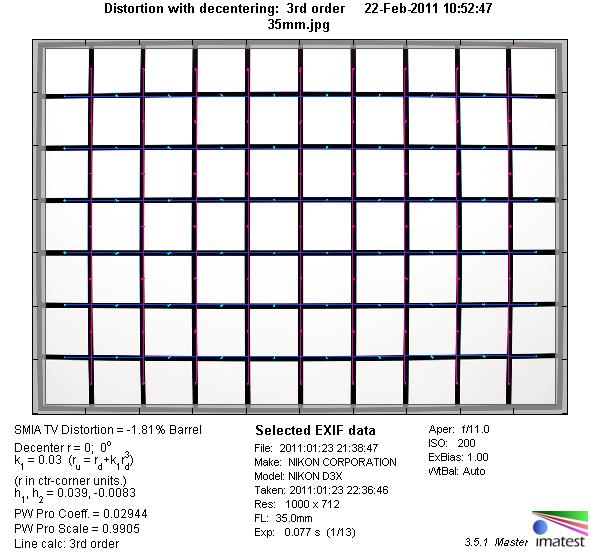|
Page 2 of 3

Distortion
The Zeiss Distagon 35mm f/2 produces a moderate degree (~1.8%) of barrel distortion.

The chart above has a real-world size of about 120x80cm.
Vignetting
The vignetting characteristic seems to be a real weakness of Zeiss Z-series lenses when used on full format DSLRs. The Distagon shows a fairly extreme deterioration of ~1.9EV at f/2 - this will be visible in most scenes. The problem is still very pronounced at f/2.8 (@ ~1.1EV) but it's not overly significant anymore from f/4 onwards.
We're performing our vignetting analysis based on
(uncorrected) JPEGs straight from the camera. The JPG engine of the Nikon D3x features a rather flat
gradation curve, thus has a moderate contrast characteristic, resulting in comparatively low vignetting figures - the
corresponding Canon figures are roughly 40% higher due to the more
aggressive default contrast setting.

MTF (resolution)
The Zeiss was able to deliver convincing results during our resolution tests. The center performance is great straight from f/2 onwards. The borders/corners follow on a good to very good level here. The peak performance is reached between f/4 and f/5.6 - the quality is very high across the frame here. Diffraction effects are starting to have an impact from f/8 onwards. However, the quality is still easily usable at f/11.
Please note that the MTF results are not directly comparable across the different systems!
Below is a simplified summary of the formal findings. The chart shows line widths
per picture height (LW/PH) which can be taken as a measure for sharpness.
If you want to know more about the MTF50 figures you may check out the corresponding
Imatest Explanations

Chromatic Aberrations (CAs)
Lateral CAs (chromatic aberrations, color shadows at harsh contrast transitions) are moderate at around 1.4px for large apertures, increasing to around 1.8px stopped down to f/11.
It is possible to correct lateral CAs in most modern RAW converters. And many modern Nikon DSLRs already do this for you in-camera if you shoot JPG.

Bokeh
One of the main features of large aperture lenses is to seperate the main subject from the background. In such an image the quality of the bokeh (out-of-focus blur) is of major significance.
The bokeh in the transition zone shows traces of nervousness, but actually it's very smooth for a lens in this class.
Background highlights retain a circular shape throughout most of the aperture range, except towards the image corners. Due to vignetting they are cut off on one side at f/2. There is a visible amount of outlining as well as some traces of bokeh fringing (which is typical for this lens class, see next section). Bokeh fringing can be reduced by stopping down, however the outlining remains.

Bokeh Fringing / Longitudinal Chromatic Aberrations (LoCA)
LoCAs (non-coinciding focal planes of the various colors) are a common issue with relatively fast glass. As you can
notice below, the halos have different colors - magenta (red + blue) in front the focus point
and green beyond. Truly "apochromatic" lenses don't show LoCAs but these lenses are very rare especially
below 100mm. Unlike lateral lateral CAs, LoCAs cannot easily be fixed in post processing.
Typical for most fast primes the ZF 35 shows some amount of LoCAs at large aperture settings, which can of course be reduced by stopping down. From f/4 onwards LoCAs are no longer field-relevant (except for scenes with very high contrast, which amplifies the issue).
|